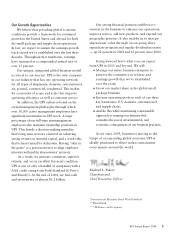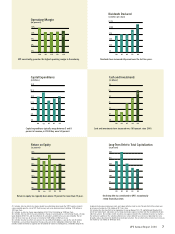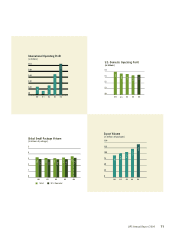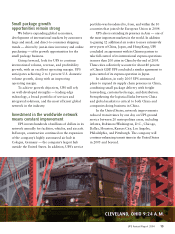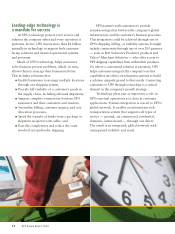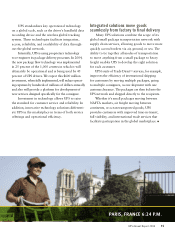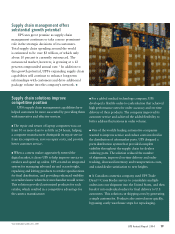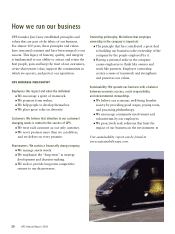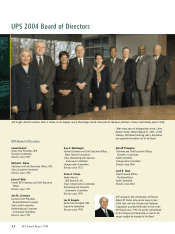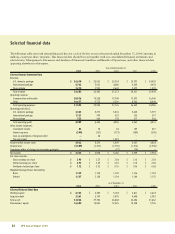UPS 2004 Annual Report Download - page 17
Download and view the complete annual report
Please find page 17 of the 2004 UPS annual report below. You can navigate through the pages in the report by either clicking on the pages listed below, or by using the keyword search tool below to find specific information within the annual report.
Effective supply chain management is becoming
increasingly critical to virtually all businesses, large
and small. It helps these businesses expand their markets,
improve cash flow, deliver better customer service,
differentiate products, and improve productivity.
UPS has extended its value proposition to
customers by helping them synchronize the flows of
goods, information, and funds through its supply
chain offerings. The company’s expanding supply
chain portfolio leverages its international presence,
infrastructure, extensive customer base, and network
management expertise. When combined with package
delivery services, supply chain management capabilities
help UPS to deepen and extend customer relationships
around the globe.
UPS Supply Chain Solutions and other of our non-
package businesses offer more than 60 products and
services in transportation and freight management,
logistics and distribution, international trade, financial
services, and consulting. Its infrastructure includes
facilities that handle such diverse tasks as overseeing
global freight shipments, filling orders, performing
technical repair and deploying critical parts, and
managing customs brokerage.
These business units offer technology platforms
that give customers extensive visibility into their
global supply chain activities for better up-to-the-
minute management decisions.
All of these capabilities help UPS to design
unique solutions for customer needs on an
increasingly global scale. UPS has targeted several
industries where it sees substantial supply chain
management growth opportunities, including the
health care, automotive, high-tech, retail, consumer,
and government sectors.
UPS Supply Chain Solutions is the largest
business unit within the non-package segment.
In 2004, net revenue increased 10 percent to $2.35
billion. Contributing to Supply Chain Solutions’
performance has been the on-going integration
of acquisitions that have expanded its reach,
capabilities, and customer base.
The latest acquisition, Menlo Worldwide
Forwarding, was completed at the end of 2004 and
added guaranteed, heavy air freight capabilities to
the UPS portfolio of solutions. With the addition of
Menlo, UPS can now offer expanded time-definite
products, such as overnight, two-day, and deferred
delivery of heavy air freight in North America.
Menlo also substantially increases UPS Supply Chain
Solutions’ ocean and customs brokerage volume.
Many UPS solutions combine the scope of its
global small package transportation network with
supply chain services, allowing goods to move more
quickly across borders via air, ground, or sea. The
ability to tie together all modes of transportation
to move anything from a small package to heavy
freight enables UPS to develop the right solution
for each customer.
UPS’s suite of Trade DirectSM services, for example,
improves the efficiency of international shipping
for customers by moving multiple packages, going
to multiple consignees, as one shipment with one
customs clearance. The packages are then fed into the
UPS network and shipped directly to the recipients.
Whether it’s small packages moving between
NAFTA markets, air freight moving between
continents, or ocean-transported goods, UPS
provides customers with improved time-in-transit,
full visibility, and international trade services that
facilitate participation in the global marketplace. n
UPS standardizes key operational technology
on a global scale, such as the driver’s handheld data
recording device and the wireless global tracking
system. These technologies facilitate integration,
access, reliability, and availability of data through-
out the global network.
Internally, UPS is using proprietary technology
to re-engineer its package delivery processes. In 2004,
the new package flow technology was implemented
in 25 percent of the 1,000 centers in which it will
ultimately be operational and is being used by 45
percent of UPS drivers. We expect this $600 million
investment, when fully implemented, will reduce operat-
ing expenses by hundreds of millions of dollars annually
and also will provide a platform for development of
new services designed specifically for the consignee.
Investment in technology allows UPS to raise
the standard for customer service and reliability. In
addition, innovative technology solutions differenti-
ate UPS in the marketplace in terms of both service
offerings and operational efficiency.
PARIS, FRANCE 6:24 P.M.


